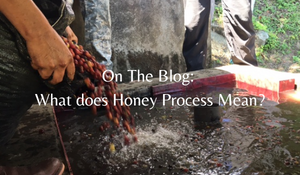What is Honey Processed Coffee?
Jun 19, 2022
When we say natural process vs honey process, it's only natural to think that in the latter, honey is used. As it turns out, that is incorrect! Before we get into how it is actually done, let's go over a brief review of natural process coffees.
Natural process also means drying the fruit. This is the oldest processing method and only works in very warm and dry climates so as to prevent molding of the fruit. Drying the fruit around the bean allows for incredible fruity notes to remain!
In between the two processes mentioned above is washed process. This is a specialty process that removes the fruit mechanically. The beans are then put into fermentation tanks. "Determining when to end the fermentation is very important – over-fermented coffee will taste sour! Once the stickiness is used up, the remnants of the mucilage are washed off using copious amounts of water. (The huge amount of water used to wash off the mucilage is one of the worst environmental impacts of coffee production, but there are some newer innovations that decrease, recycle and filter the water used in this method.)"
Next, honey process.
"Honey process is currently all the rage in Costa Rica and it has started to spread to all the other Central American countries. Remember that the mucilage of the coffee cherry is sticky and slimy, so it is sometimes called “honey”. During the Honey Process, coffee is dried with some or all of the mucilage remaining on the parchment encasing the seed. Coffee cherries are picked, sorted, depulped, and then moved to drying patios or beds for various periods of time.
Because there is a little bit of fermentation happening in the short amount of time it takes for the mucilage to dry, coffees processed in this way feature a little more acidity than Pulped Naturals (Pressure-Washed) coffees, but significantly less acidity than Washed or Natural/Dried-in-the-Fruit coffees."
Drop a comment if you have any questions about these processes!

